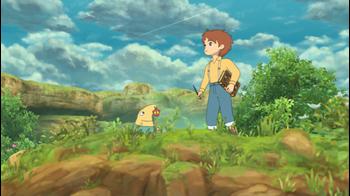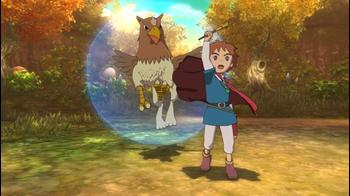
Ni no Kuni: Wrath of the White Witch Review
Level-5 is no stranger to collaborations, as made apparent by their hand in some recent Dragon Quest games. Of course, a highly respected Japanese animation studio probably isn't the kind of alliance you would expect.
Brought to you by Level-5 and Studio Ghibli comes Ni no Kuni: Wrath of the White Witch, a thrilling RPG adventure of magic and monsters. Does this unlikely combination hold up to the pedigree of its creators? The short answer is yes.
Outside of a rather unique battle system, Ni no Kuni is very much a standard JRPG reminiscent of games from the 90s and early 2000s. This of course includes the scope, which is quite large. There are on-screen encounters, command-based combat, towns, a world map and all expected trappings that come with it, dungeons and sidequests. Just listing off features doesn't really give a good idea of how much content is packed into the game.
The premise is simple, though not simplistic. Oliver, a 13 year old boy from a 1950s-esq town known as Motorville, is whisked off to a fantastical world after a tragic event changes his life. He is joined by Drippy, a wise-cracking fairy with a Welsh accent. In order to undo the tragic event, Oliver and Drippy go on an adventure in the other world to fight the evil Shadar, meeting friends and enemies along the way while visiting dangerous, yet beautiful locales.
Drama takes a backseat to the purely adventurous nature of the narrative. This makes the occasional dark scene all the more effective, but it never contradicts the tone of the game, which is generally very light. The fact none of the tonal shifts are jarring is impressive, keeping things consistent even when surprising twists come into play.
The characters and dialogue are incredibly charming. This is partially due to the voice acting, which ranges from passable to excellent. British and Welsh accents are common, which give the world a nice bit of variety when added to the American accents of Oliver and the inhabitants of Motorville. The star of the show is Drippy, whose entertaining way of speaking and acting serve as a constant reminder this is a light-hearted adventure that just wants you to have fun.
Since the game's reveal, the visuals have been a major selling point. Studio Ghibli fans will not be disappointed by the absolutely stunning art style, which blurs the line between game and anime. The world design is just as beautiful, taking a standard fantasy setting and giving it that distinct Ghibli flavor. This is of course more noticeable in animated cutscenes, but the game proper is no slouch either when it comes to Ghibli-isms.
The music, scored by veteran Ghibli composer Joe Hisaishi, is just as stunning as the majority of his works. The somber, elegant, and uplifting tracks accompany the visuals perfectly.
One of the most important aspects of the game are Familiars, recruitable creatures used in battle. Conceptually, they share a lot in common with Pokemon. There are upward of 300 types of Familiars, some less useful than others, but all with their own unique traits and abilities. A certain character is required to capture the Familiars in battle, but only if they become infatuated, denoted by hearts appearing above their heads. This happens randomly, sometimes making taming Familiars a luck-based chore. It is possible to increase the chances of a Familiar becoming infatuated, but many are still very difficult to catch, made all the more frustrating when rare ones show up.
Outside of battle, Familiars can be equipped or fed to increase their stats. They do have a growth limit, which can be increased if they become happy, a process sped up by giving them their favorite food. When a Familiar gets to a certain level, they can also be fed something to make them undergo metamorphosis, which is similar to evolution in Pokemon where they transform into a stronger creature. Metamorphosed Familiars will start at level 1, but their stats will be better after a bit of training.
The battle system is an amalgam of many interesting ideas both new and old. It is still very much menu-based, yet it also employs mechanics more likely to be found in action RPGs. Up to three main characters participate in battle, each one accompanied by a maximum of three Familiars. The player either chooses a Familiar or the owner of the Familiar him/herself. Only one can be used at a time and any single set of characters shares HP. They can be switched out on the fly, and will actually have to be periodically, as each Familiar has a stamina stat which drains while active.
The other human characters are controlled via A.I. Free movement is possible, meaning positioning is very important. Elemental techniques come into play, utilizing a standard rock-paper-scissor like system in regards to strengths and weaknesses.
The combat employs a sort of cooldown system. When an attack is selected, the character will carry it out and then said attack will not be usable for a set amount of time. The exception is the normal attack, which causes the character to automatically move to the target if it isn't already in front of them, and strike it a set number of times in intervals depending on the character's attack speed stat. Unless cancelled out, attack can be used again right away when the short phase is finished.
But the robust combat system doesn't end there. Plenty factors, both controllable and uncontrollable come into play. Enemy attacks can be countered when defending or attacking at the right time. This can lead to the appearance of helpful objects known as "glims", which are colorful orbs that heal HP, MP and even make a character's individual special attack available. These items can turn a losing fight around in an instant.
There's a lot to keep in mind beyond standards RPG mechanics, which does make for a bit of a learning curve. However, when everything clicks, it becomes an incredibly rewarding and refreshing system like no other.
Unfortunately, there is one major flaw in the battle system, which is essentially the only aspect of the game that is anything worse than a minor complaint. The ally A.I. is very poor. With few options deciding their actions, they will frequently waste all of their MP before it's really needed, leading to some very aggravating battles where competent party members are vital. More tactical options would have helped immensely, as the meager final list does not account for many situations.
On the plus side, there are battle features that make the dismal A.I. easier to swallow. "All-out Attack" and "All-out Defense", as their names imply instructs the party members to either attack with all their might or put up their guard in the face of an enemy onslaught. While a small delay may make it too late to defend when the enemy is charging up for a big attack, it does help quite a bit. Still, the A.I. issues are too pronounced to be fully alleviated by this method.
Like most games in the genre, many areas are theme based. Whether it be a desert town, a tropical paradise right on the water, or a snowy village, you'll see the usual locations. Talking animals inhabit many, some even as a reference to Ghibli's films like My Neighbor Totoro.
A lot of time will be spent on the expansive world map. Just like in dungeons and non-town fields, enemies will spawn on the overworld, albeit in more random locations. As stated above, the world map comes with everything you would expect, and that includes vehicles such as ships. Older fans of the genre may be hit by a wave of nostalgia when walking or sailing around the map, the feeling only furthered by the beautiful art style. It isn't perfect, as the controlled characters may seem a bit too zoomed out at points which could pose a problem when entering or avoiding encounters. However, this will generally not be a major issue.
Oliver can use magic outside of battle, giving him a variety of helpful skills that come in handy for many situations. Being able to teleport to already visited towns, unlocking a treasure chest, or even just healing an ally; you'll be using magic quite a bit. Some spells may be tied to the story, and thus only usable once. While there are a few spells that do nothing but take up space, these are greatly outnumbered by ones that will be used very frequently by the end of the game.
Sidequests come in many forms, the most prominent being errands and bounties. The former are small objectives given by NPCs in need of help, while the latter are simply defeating monsters. Both give the player merit points, which can be used to buy helpful prizes, some that even add functions to the game such as jumping. There's quite a bit of variety in what the errands require you to do. One type involves another interesting feature, restoring the hearts of "broken hearted" people.
In the story, coming across someone that is broken hearted is quite common, and often becomes the end goal in many areas. These people have essentially lost a piece of their personality, throwing them into the opposite extreme. Specific virtues such as courage or restraint have been taken away, turning them into cowards or gluttons. Oliver must fix this by using his locket to give the missing piece back. This can generally be done by finding someone with an excess of a specific virtue, taking some, and then giving it to the target.
Outside of the main story, these errands can get a bit tedious as it often just comes down to walking to one end of a town, taking a piece of heart, walking to the other end, then giving the heart. Fortunately, the many interesting ways people act when losing their heart or having too much of it does further the lore and can actually be pretty fun. The circumstances surrounding these NPCs really gives the world a sort of personality that is not just superficial.
A love letter to JRPGs of the 90s that still manages to feel modern. This is something both lapsed and current fans of the genre can enjoy. With a unique combat system, a deluge of compelling content still available after the credits roll, fantastic visuals and a charming world, Ni no Kuni: Wrath of the White Witch is definitely worth a look. There aren't many better ways to start the year if you like JRPGs.



